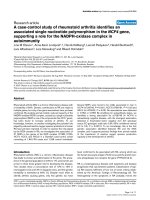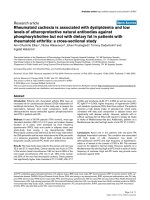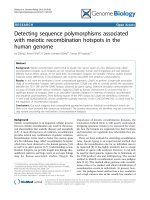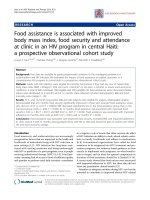Báo cáo y học: "A dentigerous cyst associated with bilaterally impacted mandibular canines in a girl: a case report" potx
Bạn đang xem bản rút gọn của tài liệu. Xem và tải ngay bản đầy đủ của tài liệu tại đây (2.02 MB, 4 trang )
CAS E REP O R T Open Access
A dentigerous cyst associated with bilaterally
impacted mandibular canines in a girl:
a case report
Shawneen M Gonzalez
1*
, Peter M Spalding
2
, Jeffrey B Payne
3
and Peter J Giannini
4
Abstract
Introduction: A dentigerous cyst is the most common developmental odontogenic cyst and is frequently noted
as an incidental finding on radiographs. The most common teeth affected are impacted mandibular third molars
and permanent maxillary canines. This case involves a dentigerous cyst encompassing the right and left impacted
mandibular canines and crossing the midline. This is, to the best of our knowledge, the first reported case of a
dentigerous cyst encompassing non-adjacent teeth and crossing the midline.
Case presentation: The patient presented to our orthodontic clinic for treatment of malocclusion. The patient was
a 10-year, one-month-old Caucasian girl with a dentigerous cyst encompassing the right and left impacted
mandibular canines and crossing the midline.
Conclusion: This case involves an unusual clinical and radiographic presentation of a dentigerous cyst. It shows a
new variant of presentation that medical professionals, specifically dentists and radiologists, should be aware of,
since a dentigerous cys t crossing the midline has not been previously reported as far as we are aware. This
additional knowledge is important for inclusion on differential diagnosis lists and aids in the development of a
proper treatment plan.
Introduction
Dentigerous cysts are the most common developmental
odontogenic cysts, accounting for approximately 25% of
all odontogenic cysts of the jaws. They are frequently
noted as an incidental finding on radiographs because a
majority of these cysts are asymptomatic and are most
commonly associated with impacted mandibular third
molars and permanent maxillary canines [1,2]. A denti-
gerous cyst presents as a well-defined radiolucent entity
surrounding the crown of an impacted tooth. The bor-
der of the cyst is continuous with the cemento-enamel
junction of the impacted tooth. This radiographic find-
ing is pathognomonic for a dentigerous c yst [2]. The
occurrence of dentigerous cysts encompassing multiple
teeth is uncommon [3-5]. All of the reported cases to
date have involved cysts localized to one quadrant of
the jaws and have encompassed adjacent teeth. As a
den tigerous cyst enlarges, it displaces the affected tooth
or teeth apically. Dentigerous cysts enlarge as a result of
the accumulation of fluid between the crown of an
unerupted tooth and the reduced enamel epithelium.
Case presentation
A Caucasian 10-year, one-month-old girl presented to
the College of Dentistry for an initial orthodontic work-
up. A digital pantomograph and a standardized lateral
cephalometric skull radiograph (Planmeca ProMax;
Planmeca Oy, Helsinki, Finland) were made. The panto-
mog raph showed impacted mandibular cani nes, both of
which were inclined mesially in a nearly horizontal posi-
tion and located in the region apical to the mandibular
incisors. There was a well-de fined radiolucent area evi-
dent around the crown of the right mandibular canin e
that was continuous with the cemento-enamel junction.
The radiolucent area measured approximately 20mm in
width and 11mm in heigh t. The appearance was c onsis-
tent with a dentigerous cyst encompassing the crown of
* Correspondence:
1
Department of Oral Biology, Section of Oral and Maxillofacial Pathology and
Radiology, University of Nebraska Medical Center College of Dentistry, 40th
and Holdrege Streets, Box 830740, Lincoln, NE 68583-0740, USA
Full list of author information is available at the end of the article
Gonzalez et al. Journal of Medical Case Reports 2011, 5:230
/>JOURNAL OF MEDICAL
CASE REPORTS
© 2011 Gonzale z et al; licensee BioMed Central Ltd. This is an Open Access article distri buted under the terms of the Creative
Commons Attribution License ( icenses/by/2.0), which permits unrestricted use, distribution, and
reproduction in any medium, provided the original work is properly cited.
the right mandibular canine (Figure 1). The follicle was
not discernible around the crown of the left mandibular
canine.
A cone-beam computed tomography scan was ordered
and made one month later (iCAT Imaging Sciences,
Hatfield, P A, USA) using a 17cm × 16cm × 17cm field
of view to evaluate the position of the canines and the
dentigerous cyst. The resultant data were reconstructed,
and multi-planar and orthoradial views were examined.
The coronal an d axial slices revealed that the d entiger-
ous cyst was larger than was apparent on the digital
pantomograph. The cyst encompassed the crowns of
bot h the right mandibular canine and the left mandibu-
lar canine. The border of the dentigerous cyst was
continuous with the cemento-enamel junction of the
impacted permanent mandibular canines (Figure 2). The
appearance was suggestive of a single dentigerous cyst
that crossed the midline and encompassed both
impacted mandibular canine crowns.
Surgical exposure of the ca nines with an incisional
biopsy of the surrounding dentigerous cyst was per-
formed by a periodontist (JBP) three months after the
initial appointment. It was noted that the dentigerous
cyst border was continuous with the cemento-enamel
junction of both impacted permanent mandibular
canines (Figure 3). The incisional biopsy specimen was
sent to the University of Nebraska Medical Center
College of Dentistry Oral Pathology Biopsy Service for
pathologic examination. Hematoxylin and eosin-stained
sections of the specimen were prepared. The histopatholo-
gic sections showed a cyst lined by thin, non-keratinized,
stratified squamous epithelium. The cyst wall consisted of
uninflamed fibromyxomatous connective tissue. These
findings were consistent with a diagnosis of a dentigerous
cyst (Figure 4).
One year later peri-apical radiographs of the mandibu-
lar canines (Figure 5) were made that showed no re cur-
rence of the dentigerous cyst and partial orthodontic
uprighting of the canines. At one year after surgery,
there was no evidence of recurrence.
Figure 1 Cropped pantomograph obtained in July 2008
showing the impacted mandibular canines and a well-defined,
radiolucent area around the crown of the impacted
mandibular right canine.
Figure 2 Reconstructed panoramic slice from cone-beam
computed tomography data. A reconstructed panoramic slice of
the anterior mandible shows a well-defined radiolucent area
encompassing both impacted mandibular canine crowns with no
separation. The border of the radiolucent area appears to be
continuous with the cemento-enamel junction of both impacted
permanent mandibular canines.
Figure 3 Clinical photograph from surgical exposure and
incisional biopsy. The photograph shows that the border of the
dentigerous cyst is continuous with both of the impacted
permanent mandibular canines.
Gonzalez et al. Journal of Medical Case Reports 2011, 5:230
/>Page 2 of 4
Discussion
There were no previous radiographs showing the
patient’s mandibular anterior teeth to determine whether
the cyst originated as a single dentigerous cyst that
enlarged and grew to encompass the other impacted
canine. There are other reported cases of a dentigerous
cyst enlarging and encompassing other adjacent teeth
[3-5]. The other possibility is that both impacted canines
had enlarging dentigerous cysts that converged, with con-
sequent resorption o f the interposing osseous border to
create one large, dentigerous cyst that included both
teeth. One previous case report described a patient
with two adjacent teeth with enlarging dentigerous
cysts that still had a bony separation between the two
[6]. This finding would lead to the possibility of one
dentigerouscystthatenlargedandencompassedthe
other impacted canine. However, the radiographic find-
ings in that case report showed the border of the
dentigerous cyst to be continuous with the cemento-
enamel junction of both impacted permanent mandib-
ular canines. On the basis of this radiographic finding,
both of these possibilities cannot be ruled out in the
absence of previous radiographs.
Conclusion
This case describes the presentation of a dentigerous
cyst that has not been previously reported. This new
presentation shows that a dentigerous cyst can encom-
pass multiple non-adjacent teeth in addition to the pos-
sibility that a dentigerous cyst might also cross the
midline. Previously, these two variants would lead to a
differential diagnosis not including a dentigerous cyst.
This is important for medical professionals to be aware
of, specifically dentists and radiologists, so that an accu-
rate differential diagno sis can be made to determine the
best treatment for the patient.
Consent
Written informed consent was obtained from the patient
for publication of this case report and any accompanying
Figure 4 Hematoxylin and eosin-stained section from incisional
biopsy showing non-keratinized, stratified squamous
epithelium lining with fibromyxomatous connective tissue
consistent with a diagnosis of dentigerous cyst.
Figure 5 Peri-apical radiographs obtained in July 2009 showin g the bilateral mandibular canines, which depict no recurrence of the
dentigerous cyst after partial orthodontic uprighting.
Gonzalez et al. Journal of Medical Case Reports 2011, 5:230
/>Page 3 of 4
images. A copy of the written consent is available for
review by the Editor-in-Chief of this journal.
Acknowledgements
J. Bruce Bavitz was involved in the revisions of the manuscript before
submission.
Author details
1
Department of Oral Biology, Section of Oral and Maxillofacial Pathology and
Radiology, University of Nebraska Medical Center College of Dentistry, 40th
and Holdrege Streets, Box 830740, Lincoln, NE 68583-0740, USA.
2
Department of Growth and Development, University of Nebras ka Medical
Center College of Dentistry, 40th and Holdrege Streets, Box 830740, Lincoln,
NE 68583-0740, USA.
3
Department of Surgical Specialties, University of
Nebraska Medical Center College of Dentistry, 40th and Holdrege Streets,
Box 830740, Lincoln, NE 68583-0740, USA.
4
Department of Oral Biology,
Section of Oral and Maxillofacial Pathology and Radiology, University of
Nebraska Medical Center College of Dentistry, 40th and Holdrege Streets,
Box 830740, Lincoln, NE 68583-0740, USA.
Authors’ contributions
SG interpreted the radiographs and the cone-beam computed tomography
scan. PS performed the orthodontic movement of the mandibular canines
once they were exposed. JP performed the incisional biopsy, curettage, and
exposure of the mandibular canines. PG performed the histological
examination of the biopsy. All authors read and approved the final
manuscript.
Competing interests
The authors declare that they have no competing interests.
Received: 27 August 2010 Accepted: 23 June 2011
Published: 23 June 2011
References
1. Daley TD, Wysocki GP, Pringle GA: Relative incidence of odontogenic
tumors and oral and jaw cysts in a Canadian population. Oral Surg Oral
Med Oral Pathol 1994, 77:276-280.
2. White SC, Pharoah MJ: Cysts and cystlike lesions of the jaws. In Oral
Radiology: Principles and Interpretation 6 edition. Edited by: White SC,
Pharoah MJ. St Louis, MO: Mosby Elsevier; 2009:346-350.
3. Sumer M, Baş B, Yildiz L: Inferior alveolar nerve paresthesia caused by a
dentigerous cyst associated with three teeth. Med Oral Patol Oral Cir
Bucal 2007, 12:E388-E390.
4. Dinkar AD, Dawasaz AA, Shenoy S: Dentigerous cyst associated with
multiple mesiodens: a case report. J Indian Soc Pedod Prev Dent 2007,
25:56-59.
5. Ertas U, Yavuz MS: Interesting eruption of 4 teeth associated with a large
dentigerous cyst in mandible by only marsupialization. J Oral Maxillofac
Surg 2003, 61:728-730.
6. McCrea S: Adjacent dentigerous cysts with the ectopic displacement of a
third mandibular molar and supernumerary (forth) molar: a rare
occurrence. Oral Surg Oral Med Oral Pathol Oral Radiol Endod 2009, 107:
e15-e20.
doi:10.1186/1752-1947-5-230
Cite this article as: Gonzalez et al.: A dentigerous cyst associated with
bilaterally impacted mandibular canines in a girl: a case report. Journal
of Medical Case Reports 2011 5:230.
Submit your next manuscript to BioMed Central
and take full advantage of:
• Convenient online submission
• Thorough peer review
• No space constraints or color figure charges
• Immediate publication on acceptance
• Inclusion in PubMed, CAS, Scopus and Google Scholar
• Research which is freely available for redistribution
Submit your manuscript at
www.biomedcentral.com/submit
Gonzalez et al. Journal of Medical Case Reports 2011, 5:230
/>Page 4 of 4









